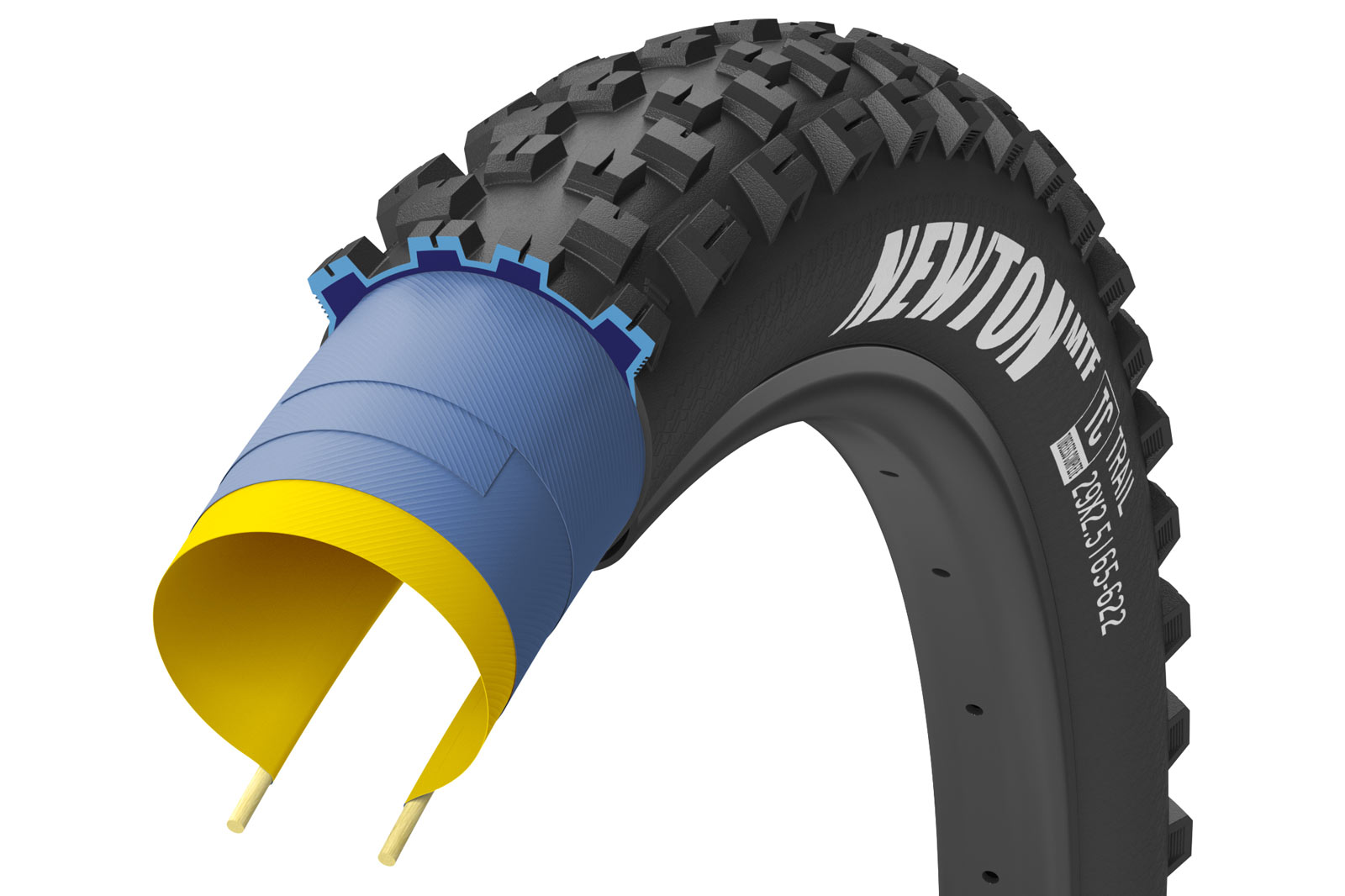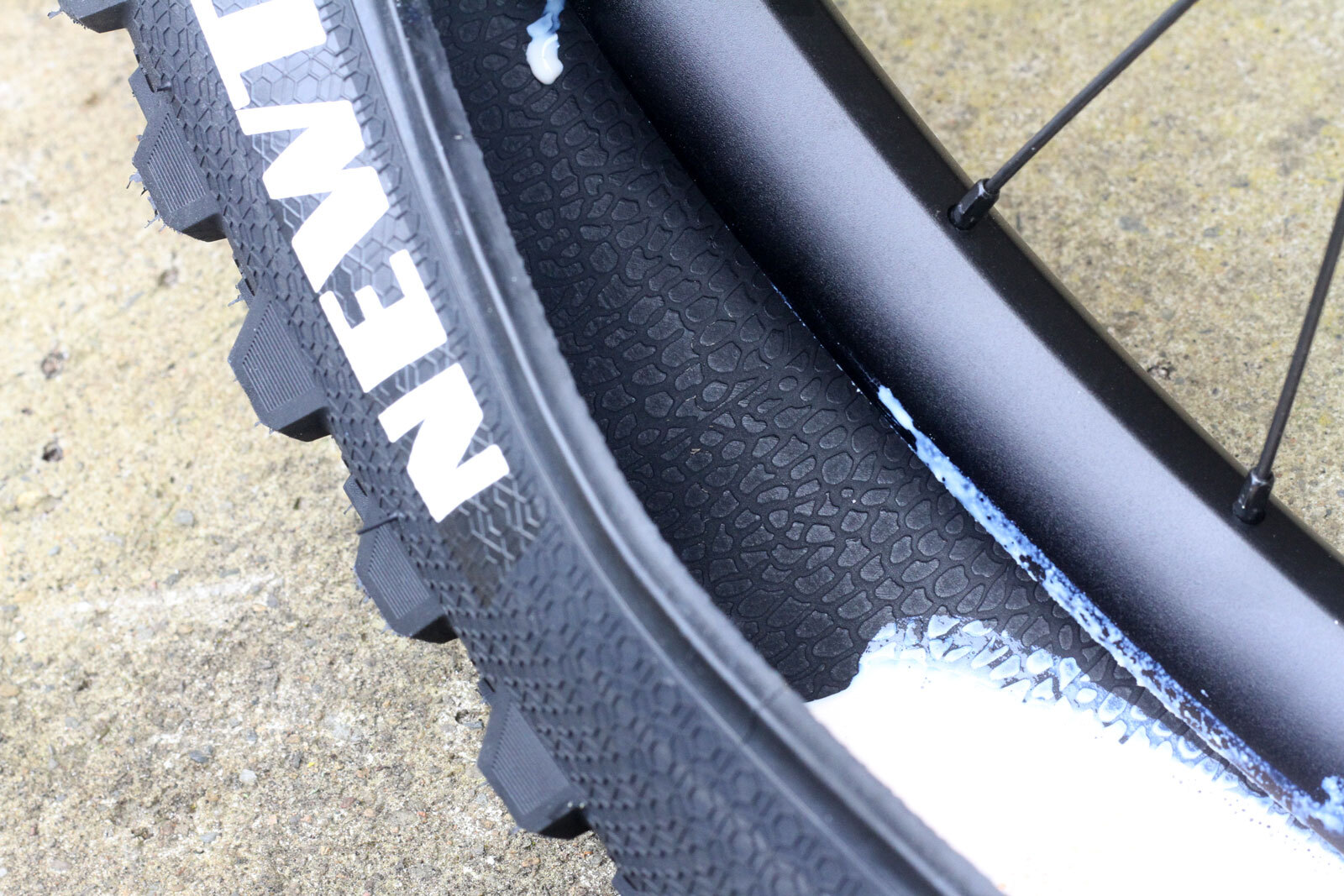We were lucky enough to be invited over to Mountain Bike Connection Winter in Massa Marittima, Tuscany to check out the latest products and technology from a handful of exciting European cycling companies, and to actually test some of it out on the flowing, well-maintained singletrack of the Trail Brothers’ network. We have a number of first ride reviews from the event coming your way; including this one on the new Goodyear Newton MTF & MTR Enduro Tires.
Goodyear Bike is today relaunching the Newton mountain bike tire after bringing development and production in-house for the first time in its four year history. The launch brings new front- and rear-specific tires; the Newton MTF and the Newton MTR, each available in 27.5″ and 29″, with the MTF available in a 2.5″ width and the MTR available in 2.4″ and 2.6″ options. All come in Trail, Enduro and Downhill Casings, bringing a total of 15 new mountain bike tires to the market.
Behind the winged-foot brand lies a company called Rubber Kinetics, the global licensee for Goodyear’s premium bicycle tires; that company launched the Goodyear Bike brand back in 2018, at a time when their tire development was outsourced to an unnamed manufacturer. While the Goodyear team was responsible for designing the tread patterns, it was the unnamed factory that developed the rubber compounds and casings and ultimately produced the product. It was essentially a Black Box model, wherein the factory would present Goodyear with some casing and compound options to choose from, then deliver a product with their chosen tread pattern a couple years down the line.
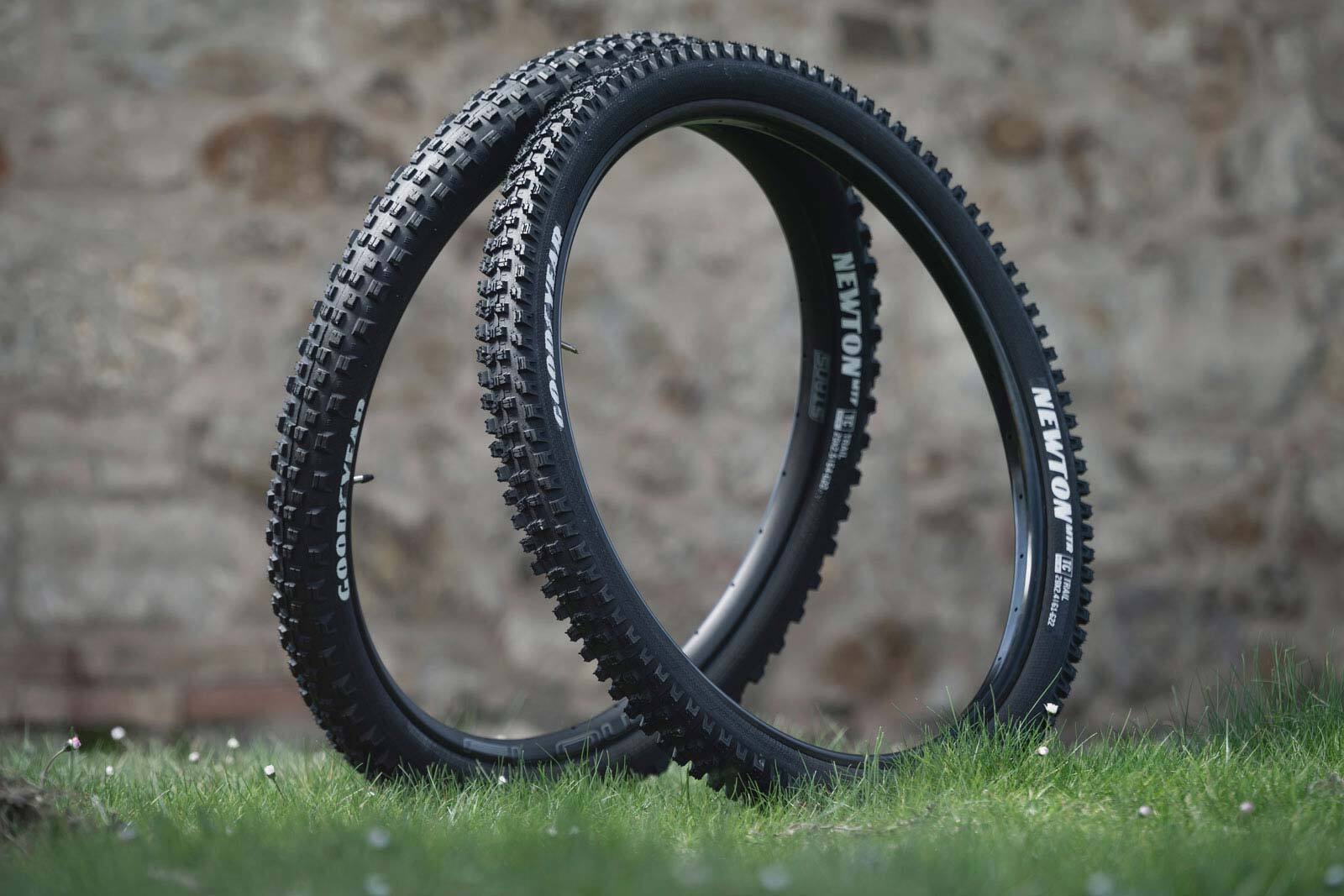
Why am I telling you this? Because as of 2021, Goodyear Bike carry out all tire development and production in-house, and the Newton MTF and MTR tires we discuss herein are the very first tires borne of the new in-house development process. The previous outsourcing model didn’t work for Goodyear; the quality of the product simply wasn’t as good as they wanted it to be, neither was the supply chain. To bring the abovementioned under their own stewardship, Goodyear Bike opened a $10 million purpose-built facility in Taiwan with 10 people on the R&D team and around 60 people on production. Every single tire that comes into the market with the Goodyear Bike brand name is now produced in that factory.
The aim with the new Goodyear Newton mountain bike tire was to produce something that could deliver high performance across a wide range of conditions. The R&D team decided the best way to approach that would be to develop dedicated front and rear-specific tires. Thus, the Newton MTF and Newton MTR came into being. We have all the details on the new range right here, including actual weights and actual widths, as well as our first ride impressions.
Goodyear Newton MTF and MTR Tires for Trail, Enduro and DH
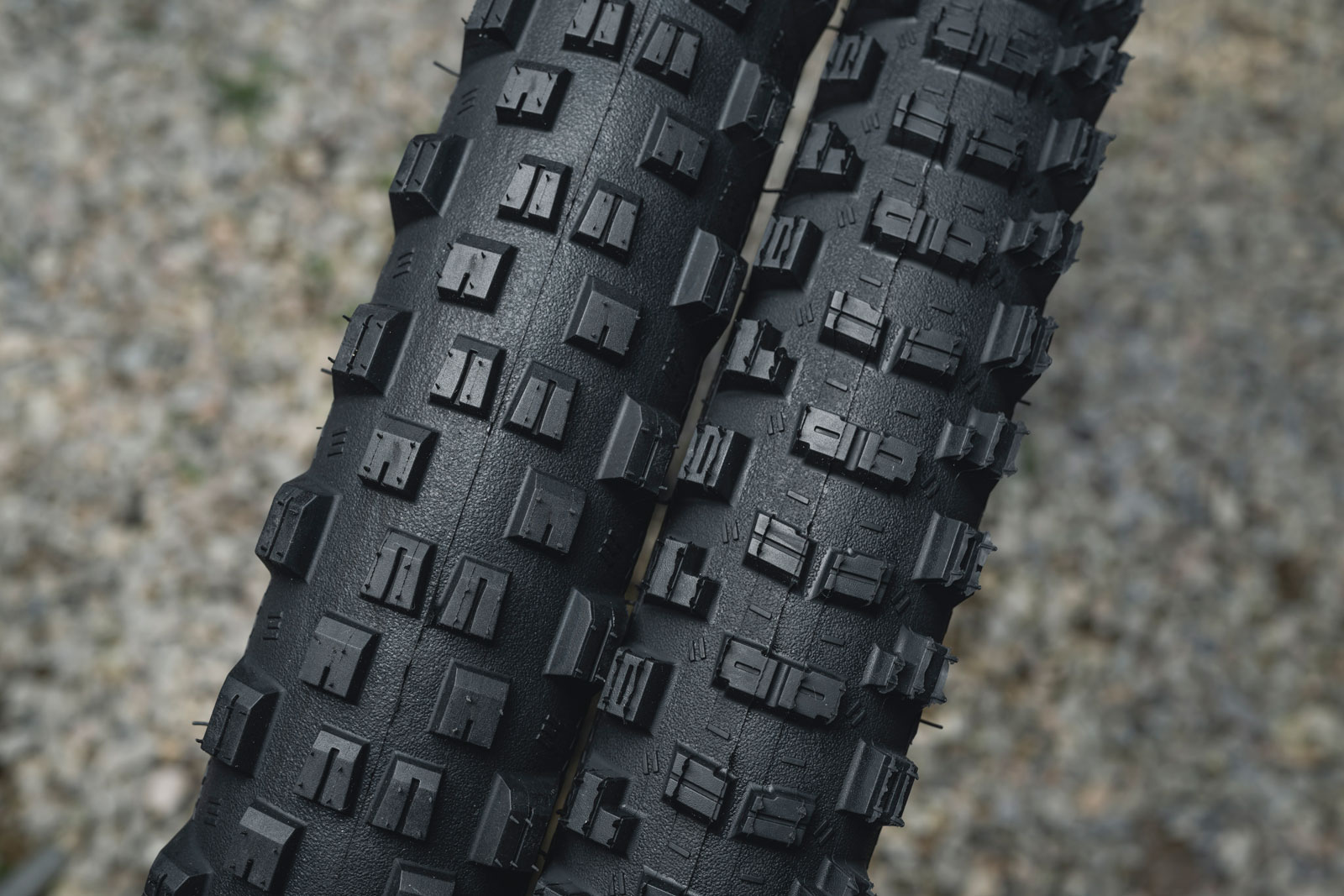
Those familiar with the original line of Newton mountain bike tires will immediately recognize the Newton MTR’s tread pattern. It is, as far as we can tell from pictures, almost identical to the original Newton launched in 2018. While that tire was sold with no specific intention for the front or rear wheel, Goodyear are now tells us this is a rear-specific tire developed primarily around forward propulsion.
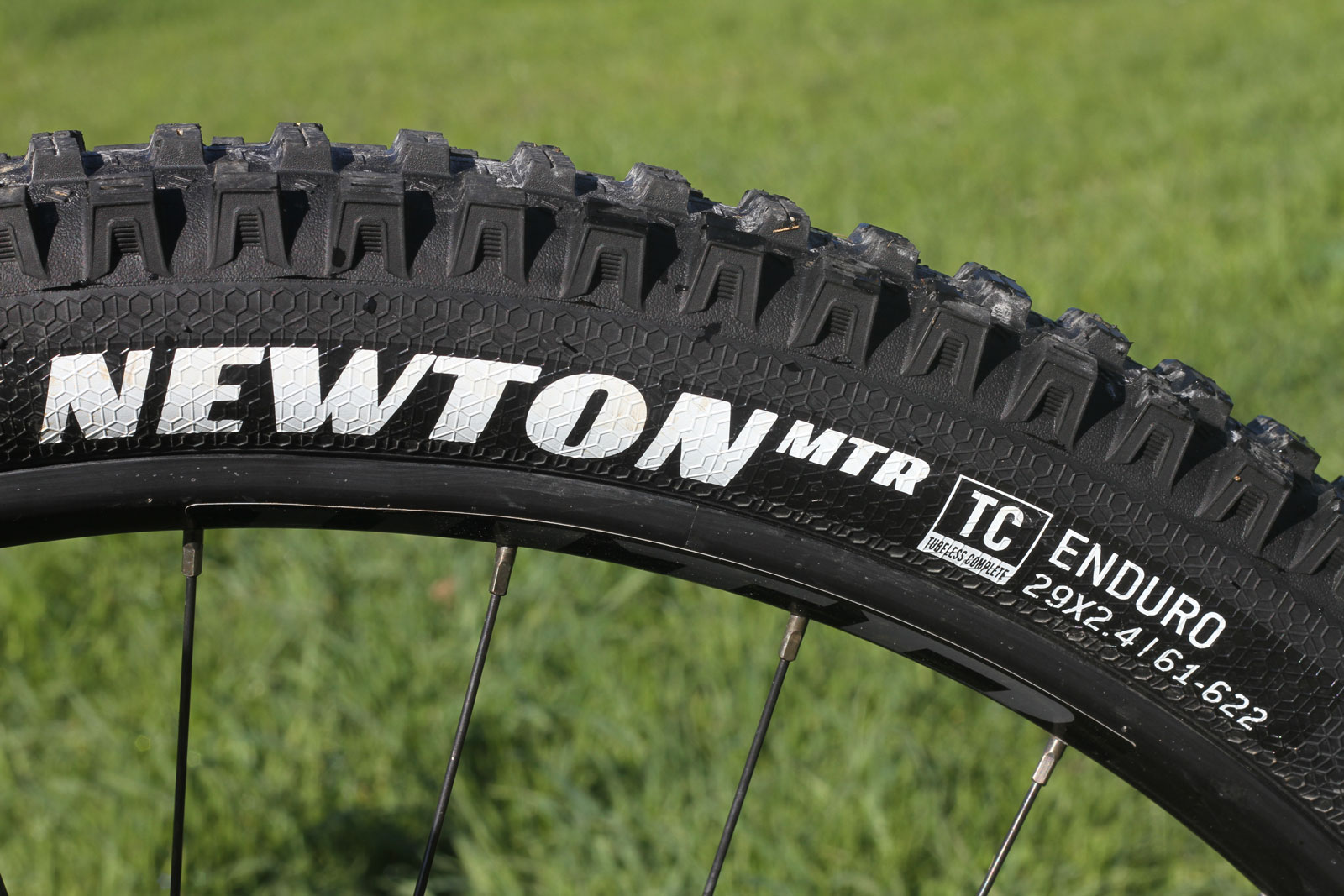
In comparison to the MTF, which we will get to shortly, the MTR is said to offer less controlled braking. To be fair, given the trailing nature of the rear tire, its ability to offer controlled braking will be somewhat reduced as compared to the front tire regardless of the tread pattern employed.
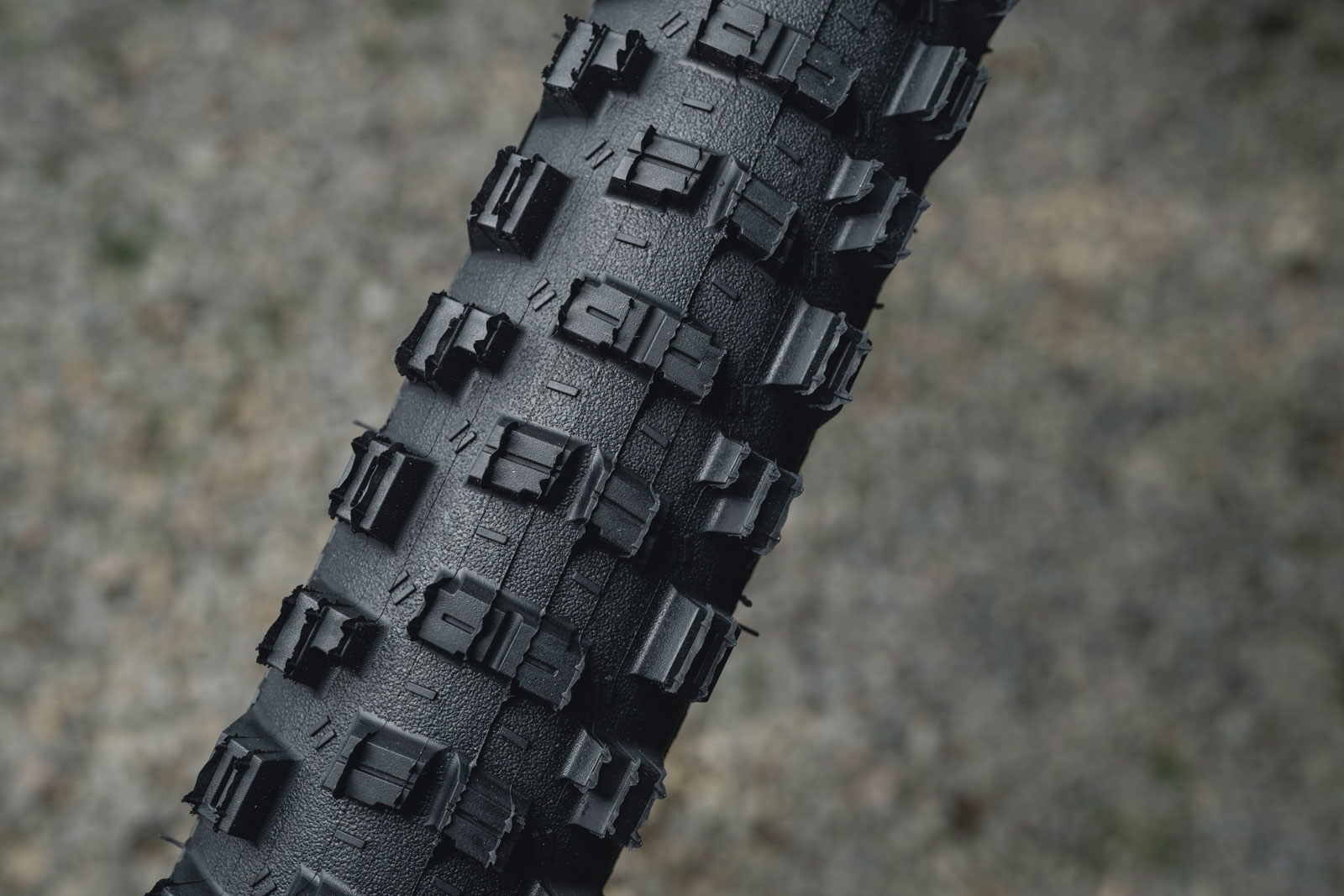
There’s no denying the Newton MTR’s similarity to the Maxxis Minion DHRII; the staggering of the alternating L-shaped and rectangular side knobs is almost identical, it is the centre tread where differences between the two are clearest. Whereas the DHRII has three distinct sets of alternating twin-blocks, the Newton MTR has just two, both of which are irregular in shape and a fair bit wider, with less pronounced ramping at the leading edge.
The rectangular and L-shaped blocks stand at around 7mm tall while the center tread blocks are much lower in profile at around 4mm tall. Both the Newton MTR and MTF tires feature raised lines throughout the valleys of the tread blocks in a bid to deter mud of that much loved peanut butter consistency from clinging to the tread for dear life.
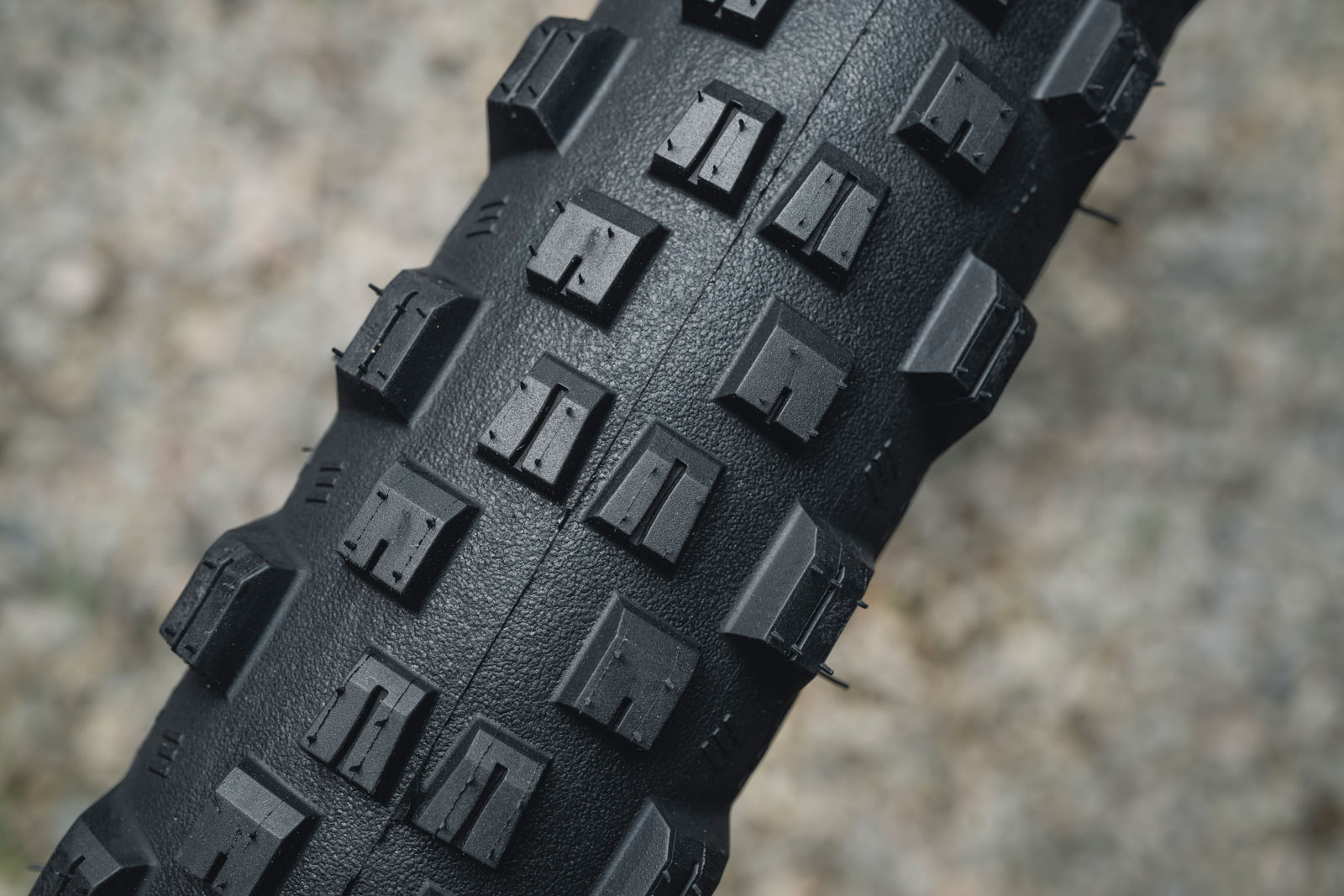
The Newton MTF front-specific tire bears little resemblance to the Newton ST tire, now retired from the range. Both the center and edge blocks feature pronounced ramping at their leading edges, presumably to aid rolling efficiency. The center tread is made up of two alternating sets of blocks, staggered in height with the taller ones standing around 5.5mm tall and the shorter ones around 4.5mm tall.
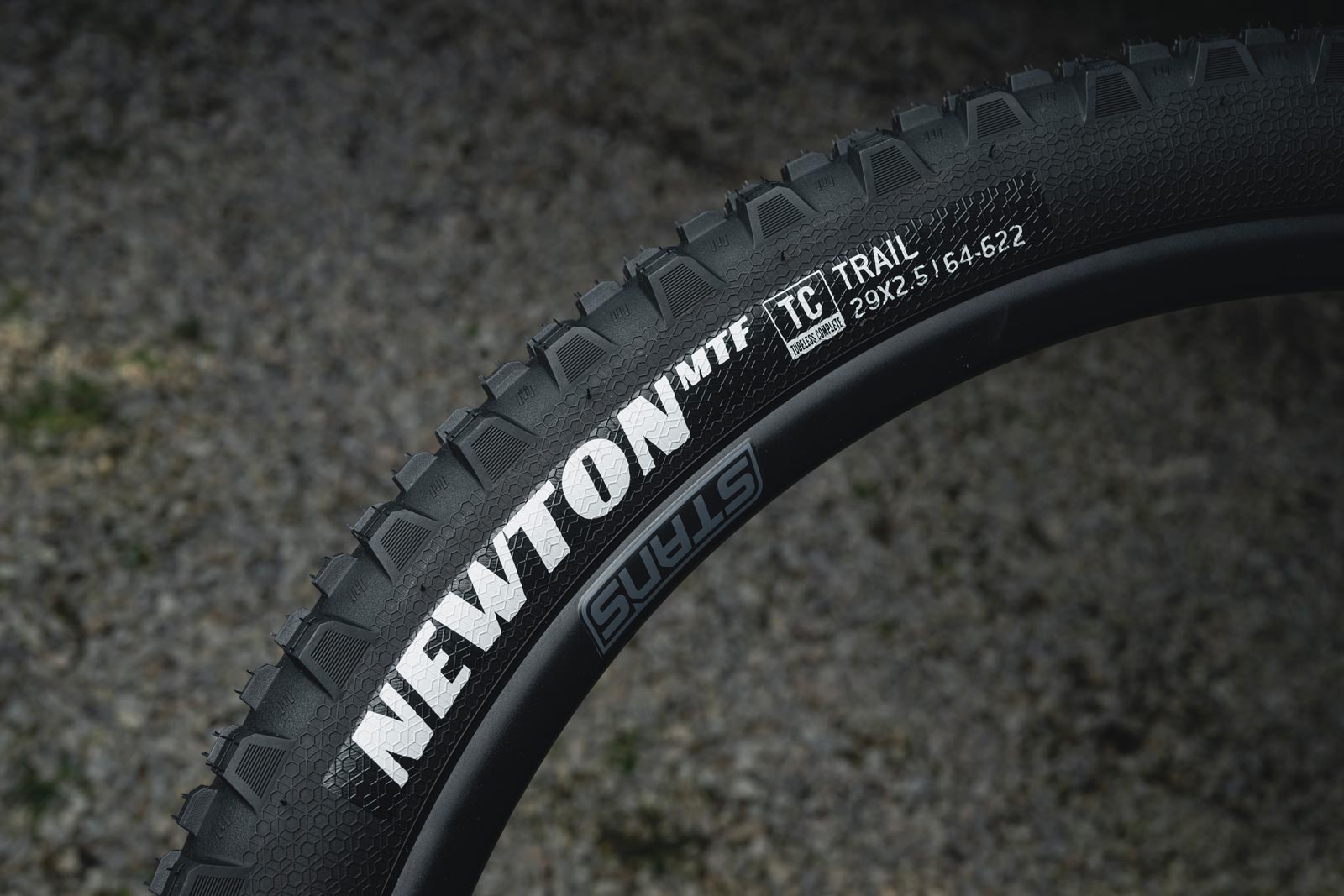
Lateral spacing between each block within the pair and their siping patterns differs too. The more widely spaced pair of center tread blocks go a long way to bridging the gap between the center tread and side knobs. The side knobs themselves stand at around 7mm tall and are staggered in terms of their distance from the center tread, with siping 2mm deep running their full length to allow for some degree of lateral flex during cornering.

Using a combination of casing construction and tread pattern block heights, Goodyear has given the MTF a far more rounded profile then the MTR, an intentional design feature they say is inspired by MX tires. The rounder the profile, the more narrow and elongated the contact patch of the tire becomes; this is said to aid braking by providing more center tread braking edges to brace against. It is also said to give rise to a more supple tire, thus improved control.
The MTR’s more squared-off profile gives rise to a wider but shorter contact patch, with all four knobs across the width of the tire in contact with the ground. This is said to improve the rear tire’s ability to drive forward propulsion. Lateral spacing between those four knobs is kept to a minimum in order to present the ground with as much surface area as possible when braking hard. Goodyear also tell us this tight spacing allows for a more consistent transition between the center tread and side knobs when leaning the bike over in turns, with less likelihood of the rear tire sliding out.
Goodyear MTB Casings and Compounds
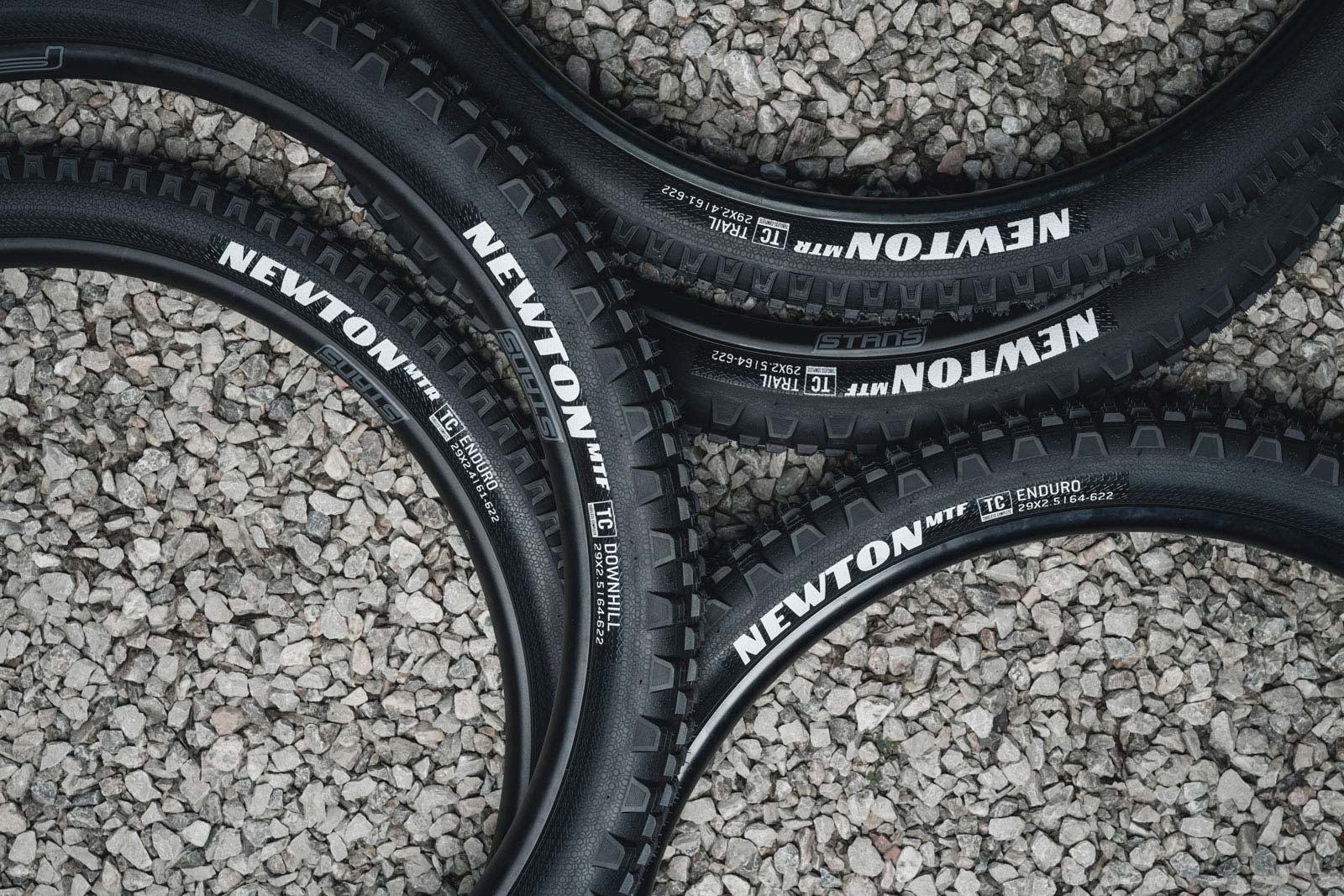
Goodyear are releasing the Newton MTF and MTR tires in three casing options; Trail, Enduro and Downhill, each with their own combination of rubber compounds chosen for their grip, rolling efficiency and durability properties.
Goodyear’s Trail Casing is made up of a single-ply of a 60 TPI fabric, so there are two plies of casing material at the sidewalls with three plies on the top. They then have an additional bead-to-bead layer of casing fabric they call Armor Protection, with a much higher rubber content that adds sidewall protection and further puncture protection, but also makes the tire less porous. The Newton MTF and MTR tires in Trail Casing both roll on their Trail 2 Rubber with 60A base compound with a softer 50A upper compound.
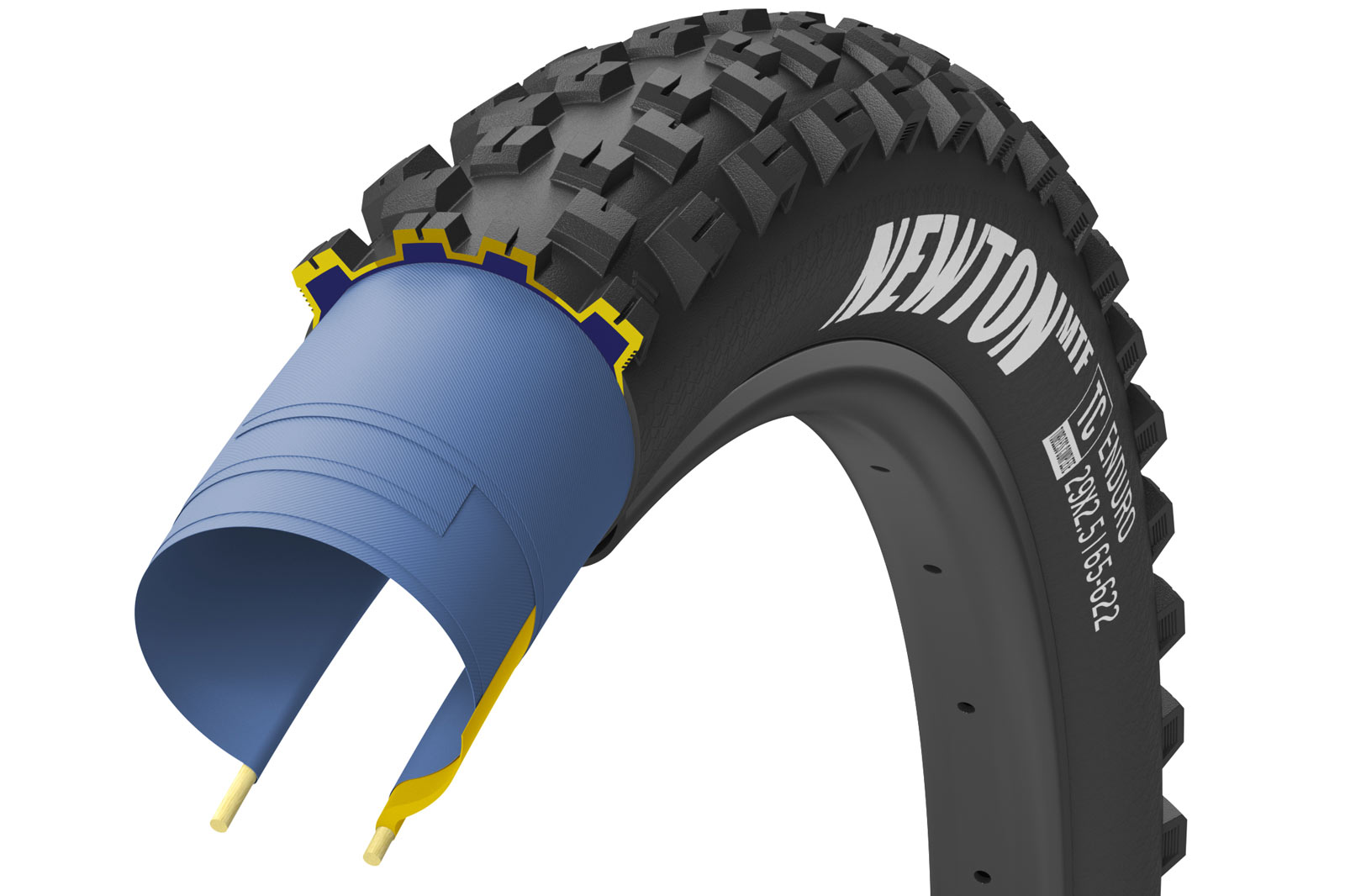
The Enduro casing tires are dual-ply, made up with a more supple 120 TPI fabric; there are 4 pieces of casing fabric at the sidewalls and 6 layers of casing fabric at the center. There’s then an additional butyl insert at the sidewalls to protect against sidewall slashes and snakebite punctures.
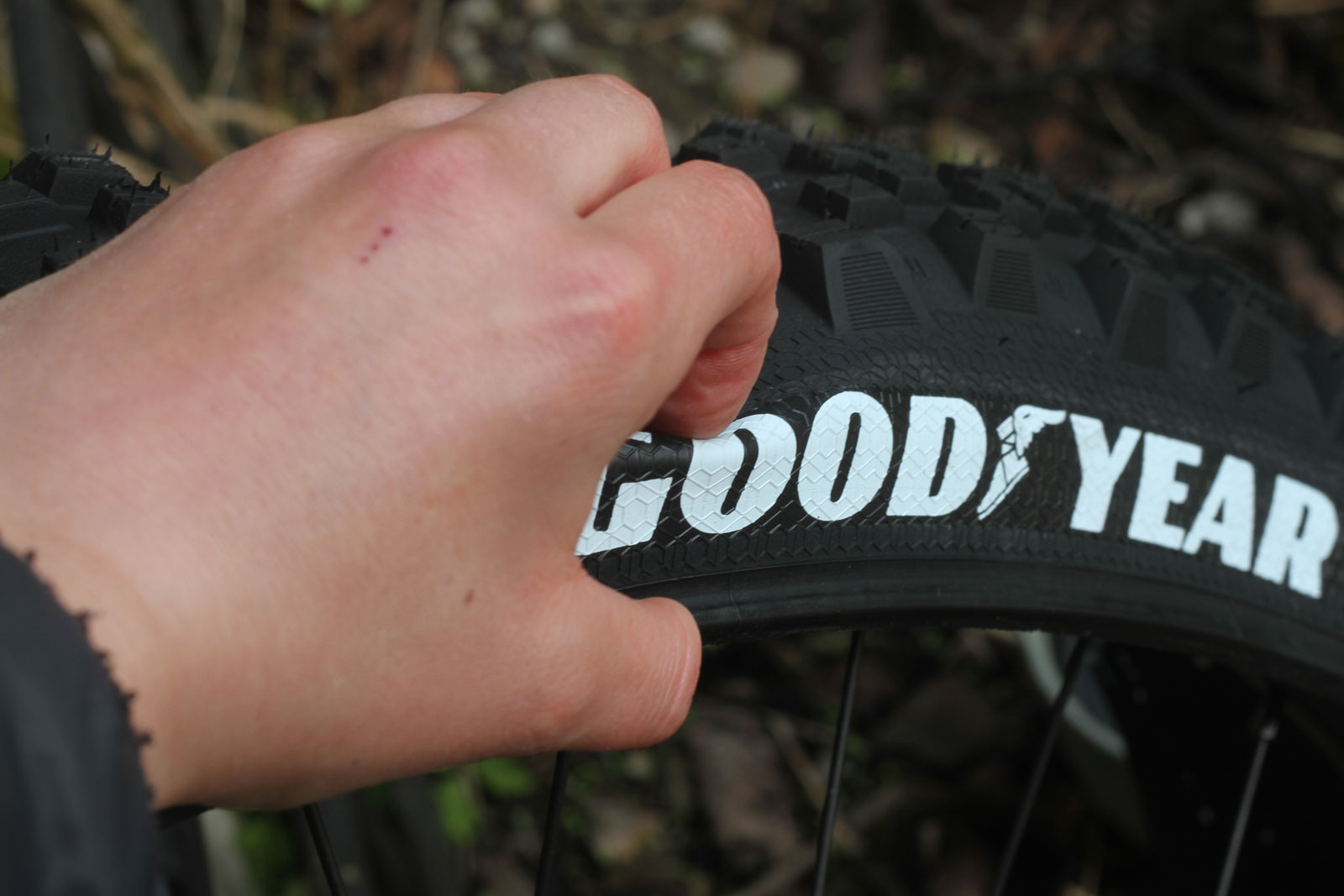
The Downhill casing is dual-ply, just like the Enduro casing, except that the fabric goes back to 60 TPI with a higher rubber content, and thus a tougher carcass. The butyl insert employed on the DH casing is thicker and taller than that seen on the Enduro casing in a bid to offer that extra puncture protection and sidewall support over a larger area.
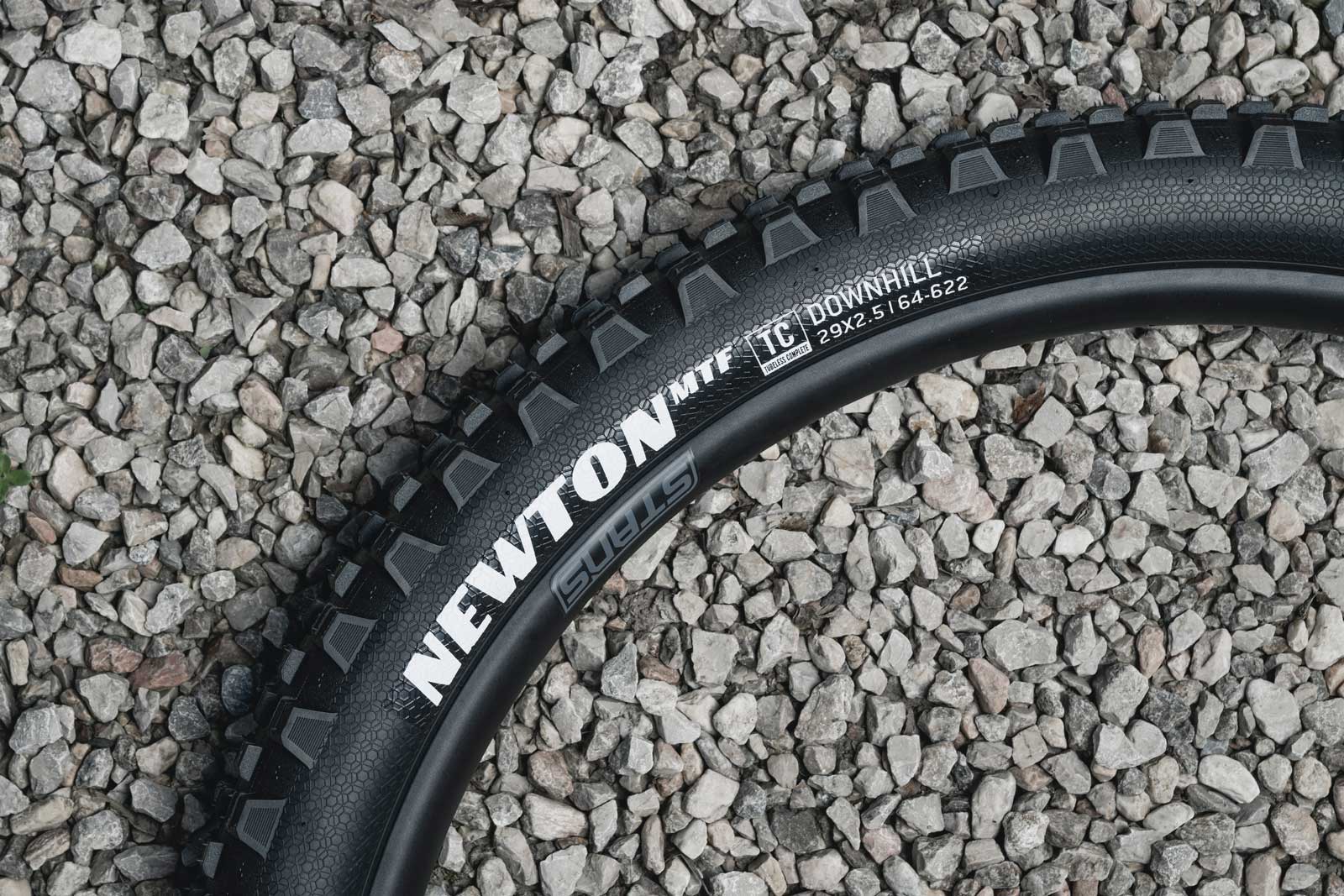
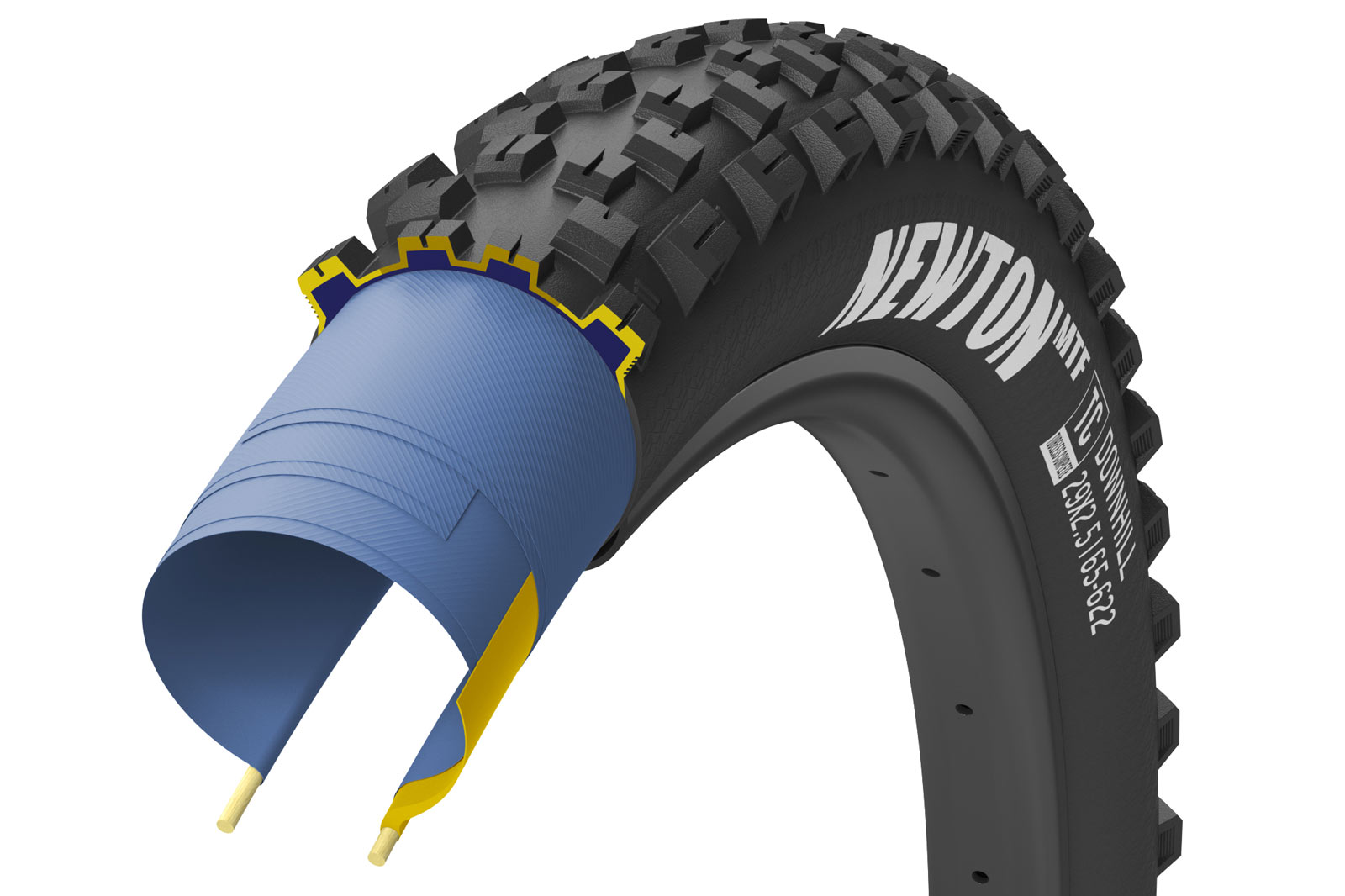
For the Enduro and Downhill casings, the rubber compounds employed differ between the MTF and MTR tires; The Newton MTF Enduro and Downhill Casing tires run the same GRIP 3S Compound to prioritize out-and-out grip, with a 42A center tread, a softer 40A edge tread, and a harder 60A base compound. The Newton MTR tire in the Enduro and Downhill casings strikes more of a balance between grip and rolling efficiency, employing the Grip 3 compound; this one has the super soft 40A compound only at the edge tread, with the 50A at the center tread and the durable 60A across the base.
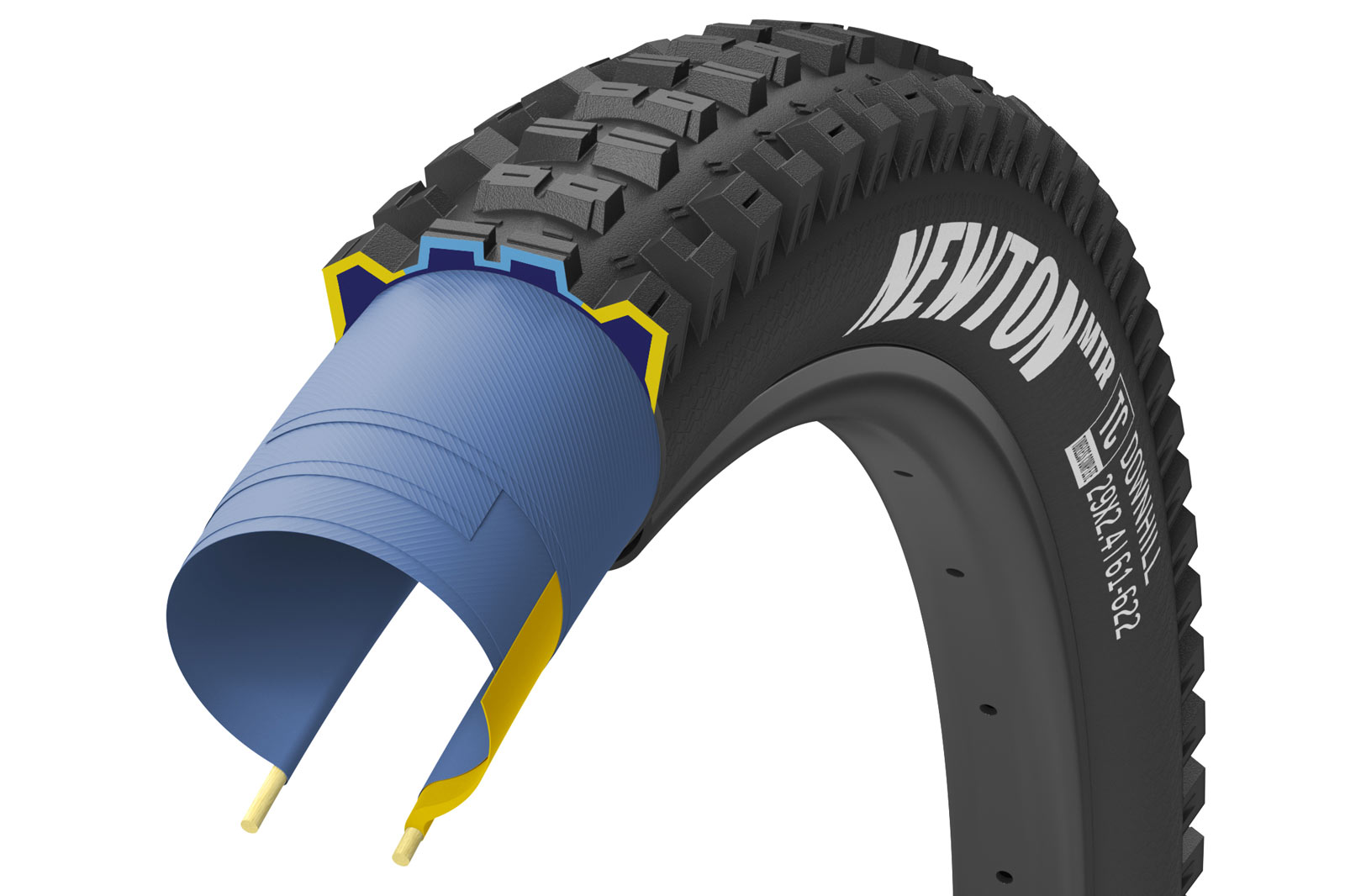
To touch, I honestly can’t really feel any tangible difference between the 42A rubber of the MTF center tread and the 50A rubber of the MTR center tread, let alone any difference between the 42A and 40A rubbers. The side knobs of the Enduro Casing tires do display fairly low rebound properties when subjected to the very scientific knob twist test, though they aren’t quite as slow to return to their original shape as the rubber of Vee Tire Co’s Snap Trail TOP40 tires.
First Ride: Goodyear Newton MTF and MTR Enduro Tires
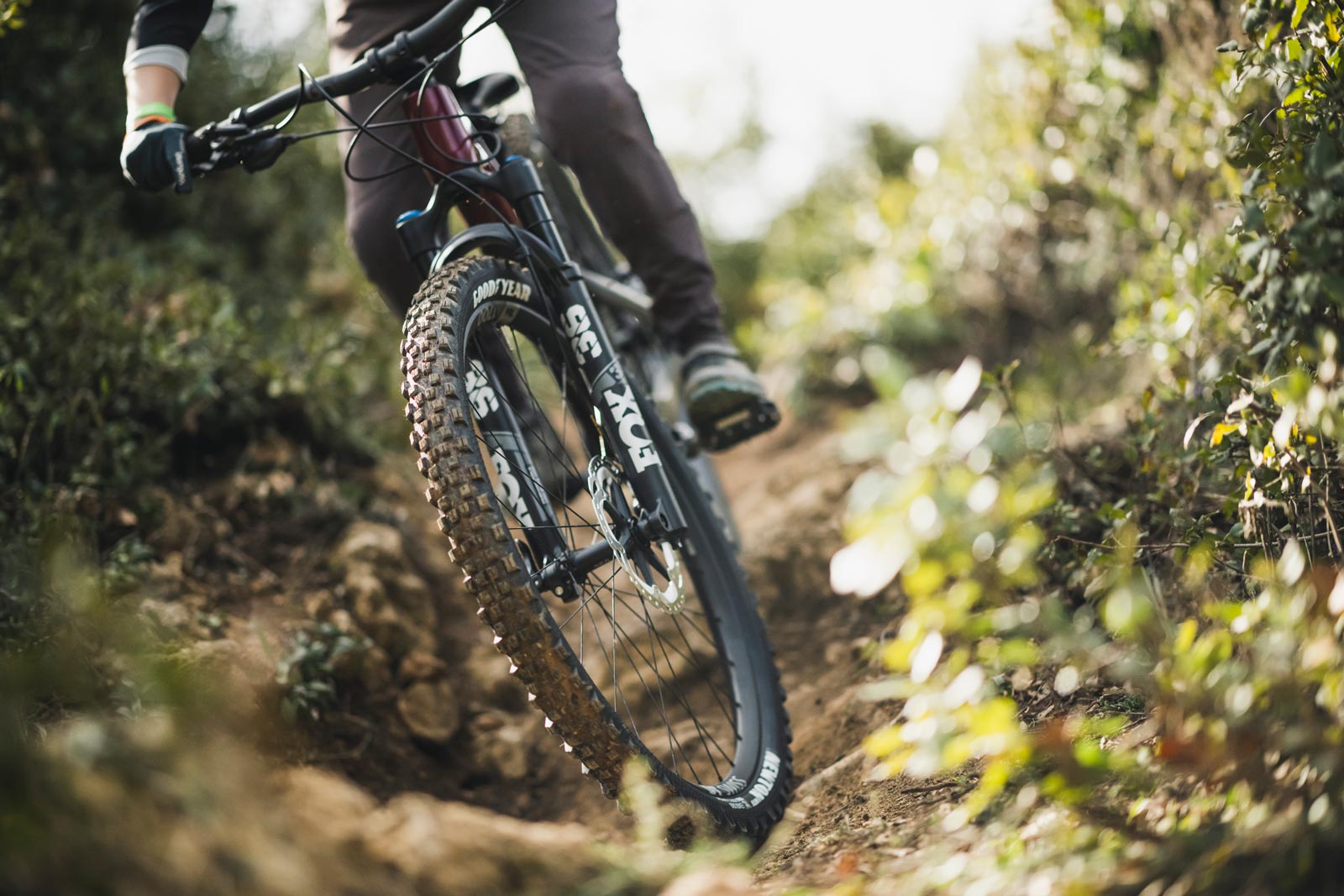
With the Canyon Spectral 125 as a test bike, I rode the 29″ x 2.5″ Newton MTF tire on the front wheel and the 29″ x 2.4″ Newton MTR on the rear, both in the Enduro Casing option which features the softer rubber compounds. Both were seated on the 30mm internal width rims of the DT SWISS XM1700 alloy wheelset.
Goodyear provide a tire pressure calculator on their website. I plugged the following information into their calculator; a rider weight of 60 kg, a riding style of “MTB Enduro”, a bike weight of 14 kg, wheel size, tire width, rim width and type and selected “Dry” for the surface conditions. Pressures of 18.7 PSI in the front tire and 19.8 PSI in the rear were recommended. According to my notes, I didn’t follow the recommendation, opting for 18 PSI in the front and 20 PSI in the rear. There were still a few wet patches about, and I tend to prefer lower pressures in any case.
Had I selected “Wet” for surface conditions, the recommendation would have been 18.7 PSI in the front and 19.8 PSI in the rear. Most tire manufacturers steer clear from recommending pressures that low; Maxxis print a minimum PSI value of 35 on their mountain bike tires, meanwhile WTB print a much lower value of 20 PSI on theirs. Continental, and now Goodyear, state no absolute minimum, only a maximum pressure of 51 PSI and 50 PSI, respectively.
I digress. In Tuscany, I spent one afternoon one these tires, but have since put in two good rides on my local trails in Scotland.
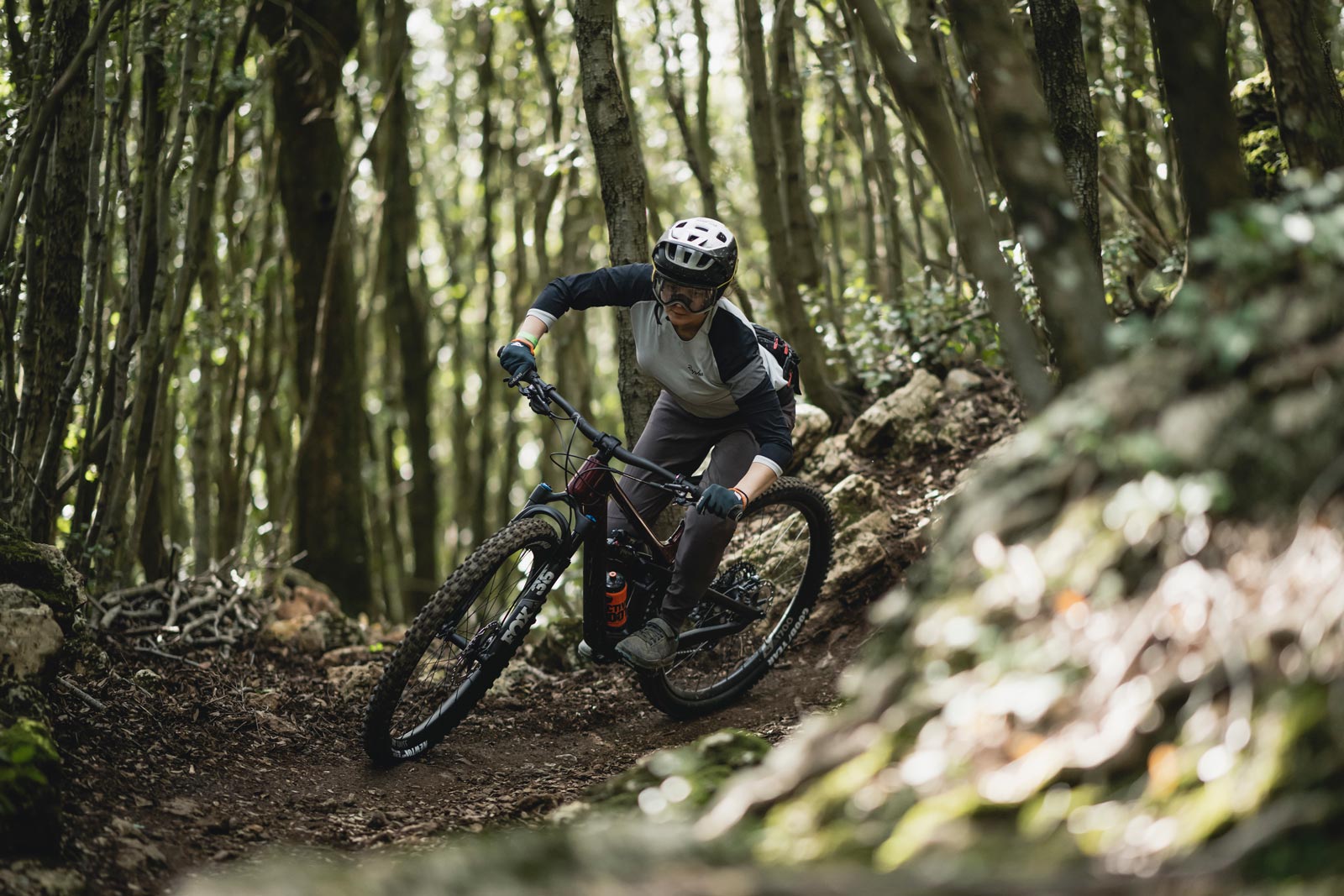
The profile of the Goodyear Newton MTF is very close to that of a 2.5″ Maxxis Assegai. Much like that popular tire, the Newton MTF encourages the rider to lean into corners, with a predictable and smooth transition from the center tread through to the side knobs. I had no qualms tipping to bike to fairly high lean angles, and never quite found the angle at which grip runs out, on the front or rear tire.
As I mentioned, the trails in Tuscany were largely dry, but soft, wet patches were lurking around corners ready to catch out unsuspecting riders. Regardless, the tires gripped the softer terrain well, presenting me with no real difficulty in handling. I felt they offered a confident and precise ride feel. I also noted that the Newton MTF offered very predictable, modulated braking characteristics.
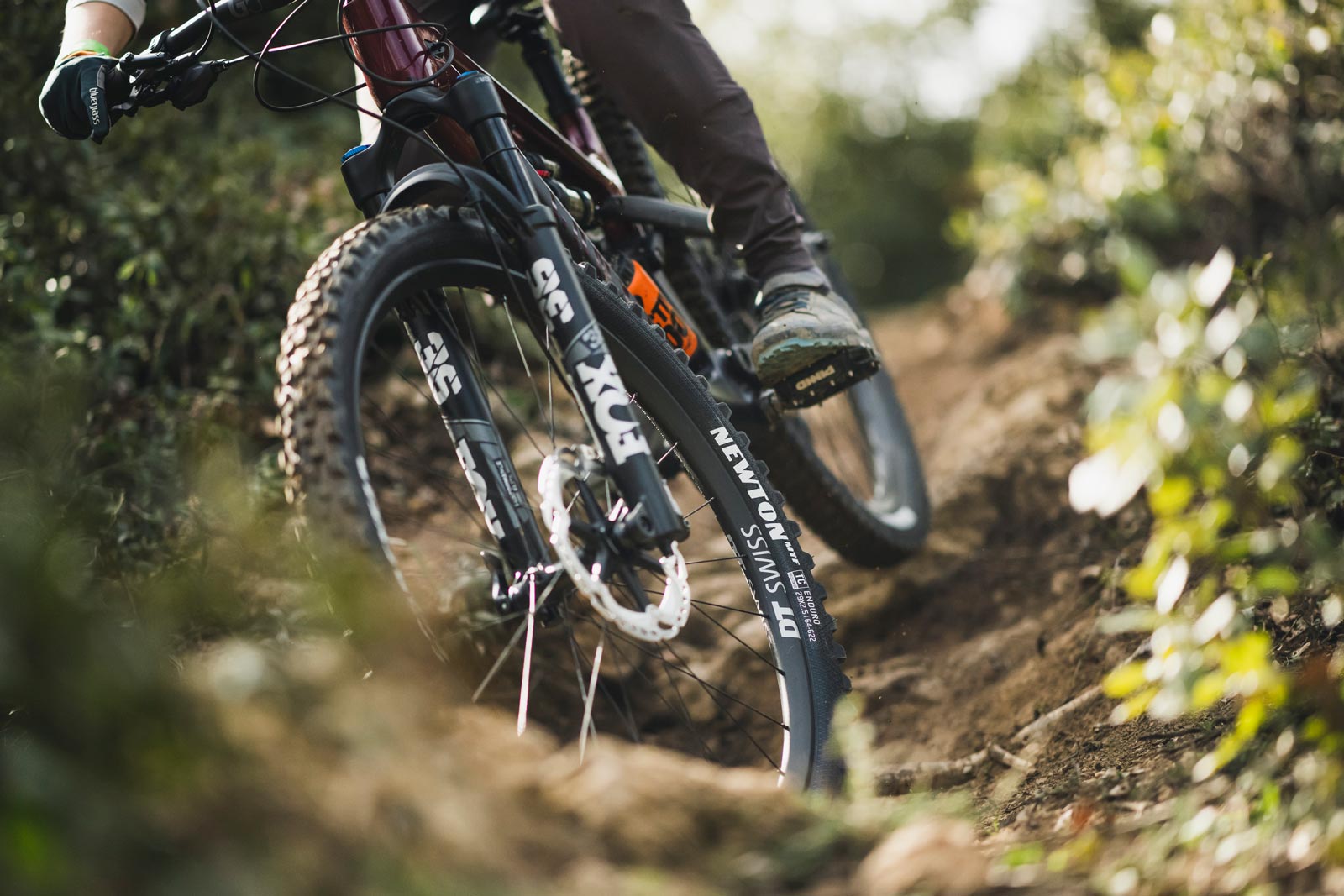
As for the Newton MTR on the rear, I noted it offered good drive when climbing loose, rough terrain out of the saddle. I also noted a lack of grip on wet rock when climbing steeper, technical sections of singletrack, however. Of course, much of a rider’s success in regard to technical climbing comes down to good technique, and well-timed application of torque combined with well-timed weighting and unweighting of the bike. I’m not the world’s best technical climber by any stretch of the imagination, but I do consider myself fairly competent. Regardless, I did feel the rear wheel spin out on occasion as the tire lost its footing on wet, slippery rocks.
My afternoon spent on the Trail Brothers singletrack was almost entirely uplifted, so I shall refrain from commenting on the rolling characteristics. I can say that I never experienced any pinging sensations from the tire carcass, even while ploughing through short sections of the rough karstified dolomitic limestone.
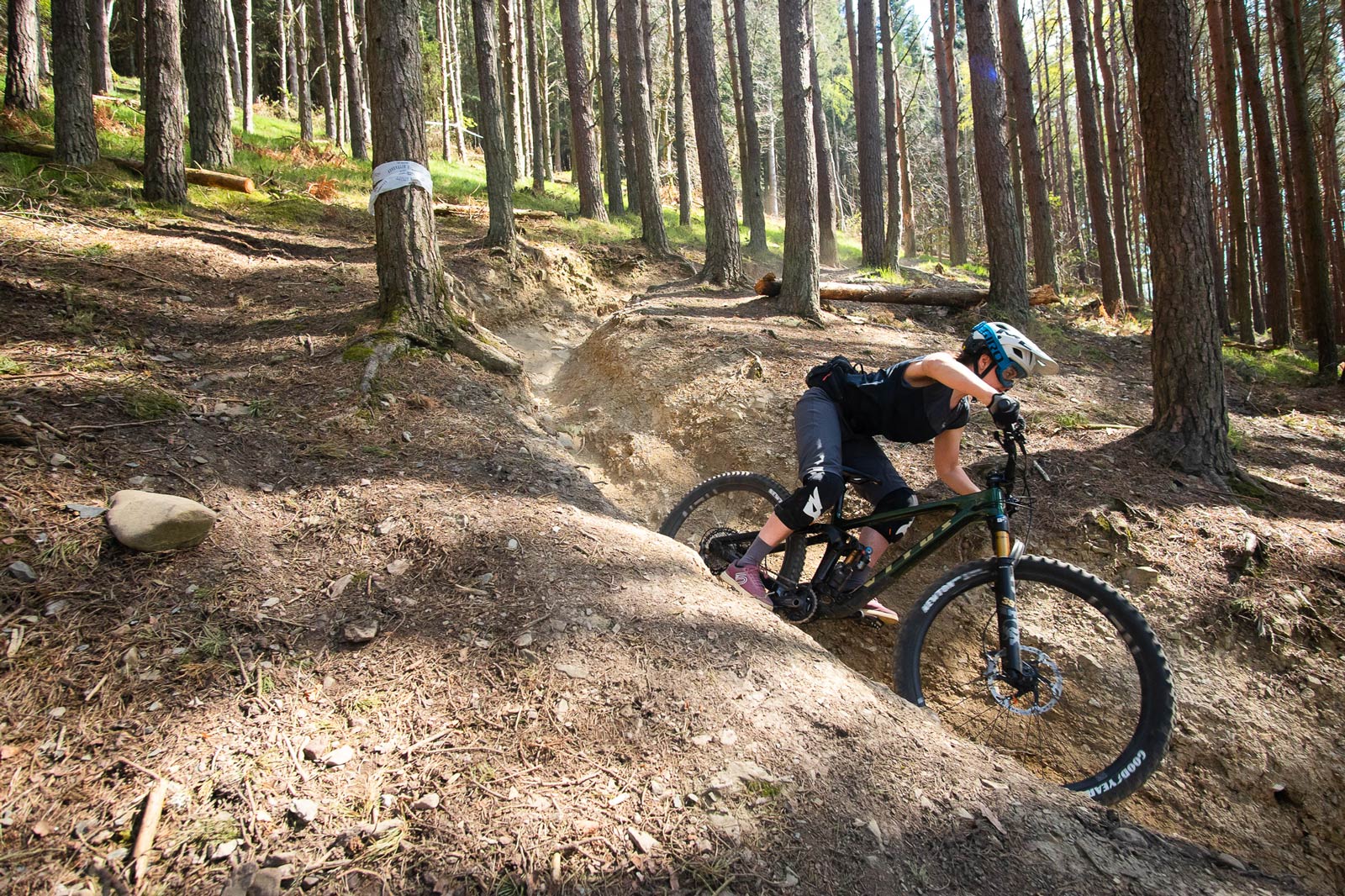
Back home in the Tweed Valley, what is normally, soft, gritty and slow rolling is now hard, rough and fast as all hell. I’ve ridden the Newton MTF 29″ x 2.5″ Enduro Casing tire and the Newton MTR 27.5″ x 2.6″ Enduro Casing tire on a Nukeproof Horizon V2 wheelset, in the context of the 2022 Vitus Sommet 297 CRX I have on test. I took the advice of the Goodyear Tire Pressure Calculator this time, running 20 PSI in the front and 23 PSI in the rear. On a full run of one of our EWS race tracks I found those pressures too harsh, as evidenced by the blood vessels in my arms coming to up to the surface caused by too much vibration.
To get a better feel for what suppleness the tire could offer this 60kg rider, I dropped the pressures to 18 PSI, front and rear, and benefited massively as a result. The carcass is now more easily deformed, helping to take away those trail chatter vibrations leading to less fatigue in the hands and arms. I can recall only one occasion where tire roll may have occurred; in a tight, bermed up corner, the kind that you would normally accelerate out of like a bullet. The tires wallowed in this turn. For me, the sweet spot tire pressure is likely somewhere around 19 PSI in the front and 20 PSI in the rear.
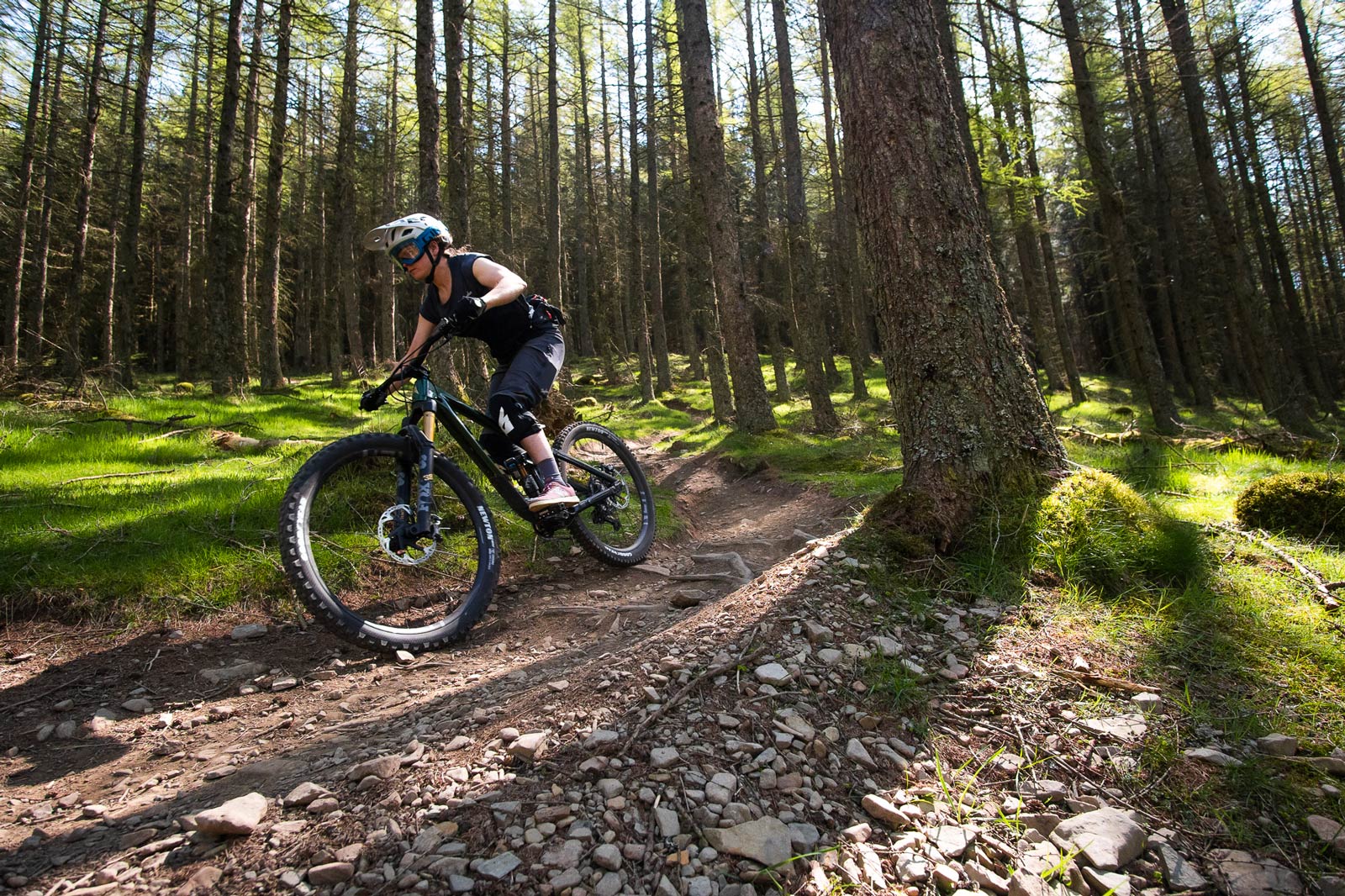
So far, my impression of the tires has been really positive, and I look forward to testing them more in the coming weeks. The Newton MTF looks like it should offer decent mud clearance. Though I felt its cornering characteristics were comparable to that of the Assegai, it should hold onto less mud as the knobs are more widely spaced. I look forward to updating you guys when our trails turn to slop once more (shouldn’t be too long now).
Goodyear Newton Actual Widths
Since taking delivery of the 29″ x 2.5″ Newton MTF and 27.5″ x 2.6″ Newton MTR Enduro Casing Tires, I have mounted them to 30mm internal width rims on the Nukeproof Horizon V2 wheelset that came stock on the 2022 Vitus Sommet 297 CRX that I have on test at the moment. With the Presta valve core removed, I was able to seat the Newton MTF onto the rim with ease using an old-but-gold Joe Blow Sport track pump. Seating the Newton MTR was a little more testing, requiring the use of the trusty AirShot. In both cases I used regular Orange Seal tubeless sealant.
The Newton MTF is sold as a 2.5″ tire, though in reality it is closer to 2.6″. Upon initial inflation, our Park Tool Digital Vernier Caliper measured it at 2.57″ on a 30mm internal width rim at 25 PSI. Two rides in, the casing has loosened off and it now measures up at 2.64″ wide. The opposite discrepancy is found with the Newton MTR. The rear-specific tire is sold as a 2.6″ tire, though in reality it is much narrower, measuring up at 2.47″ on a 30mm internal width rim at 25 PSI upon initial inflation. Two rides in, it too has loosened off to 2.53″.
| Goodyear Newton MTF 29″ x 2.5″ Enduro | Nukeproof Horizon V2 30mm INT | Width 2.64″ | 25 PSI |
| Goodyear Newton MTR 27.5″ x 2.6″ Enduro | Nukeproof Horizon V2 30mm INT | Width 2.53″ | 25 PSI |
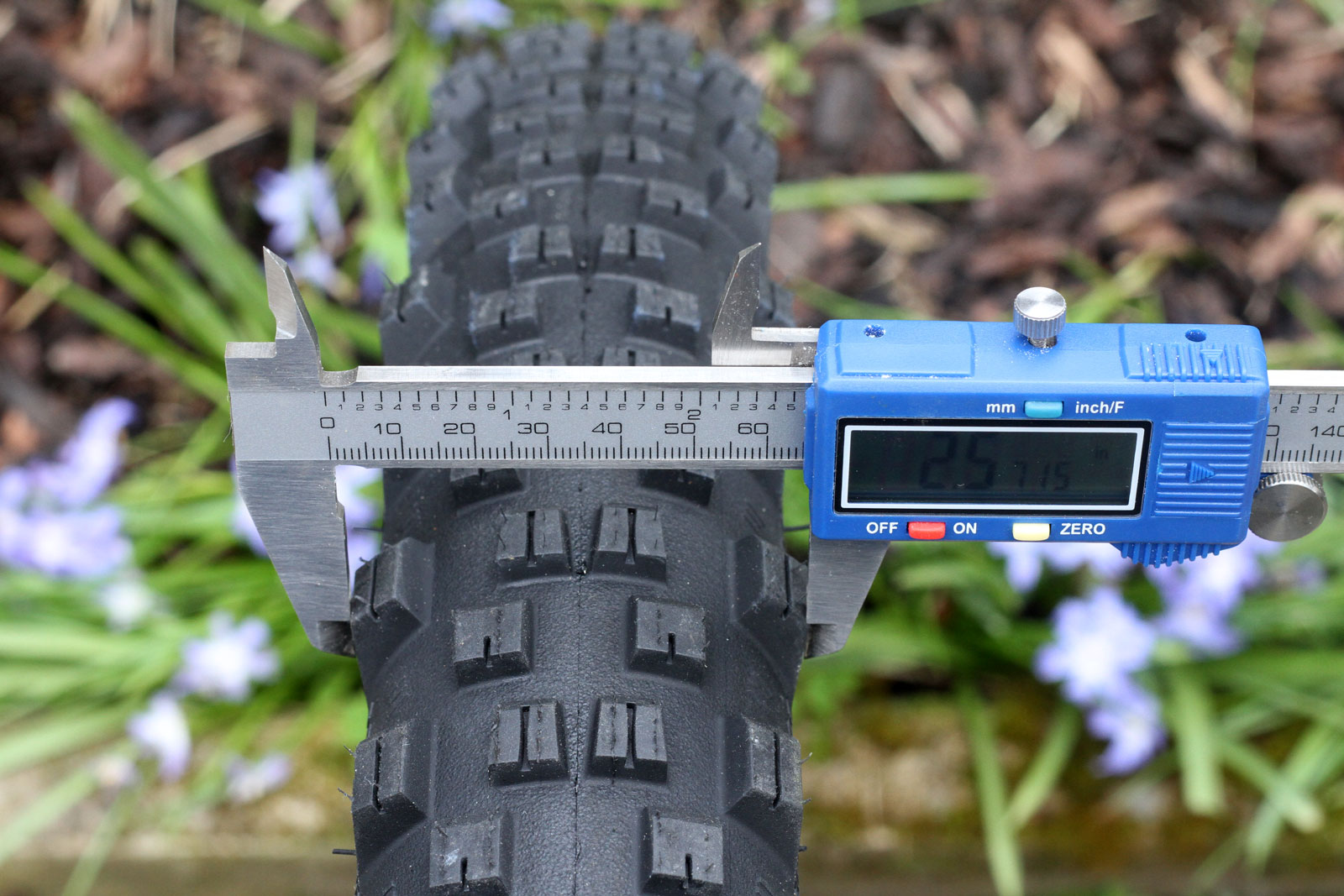
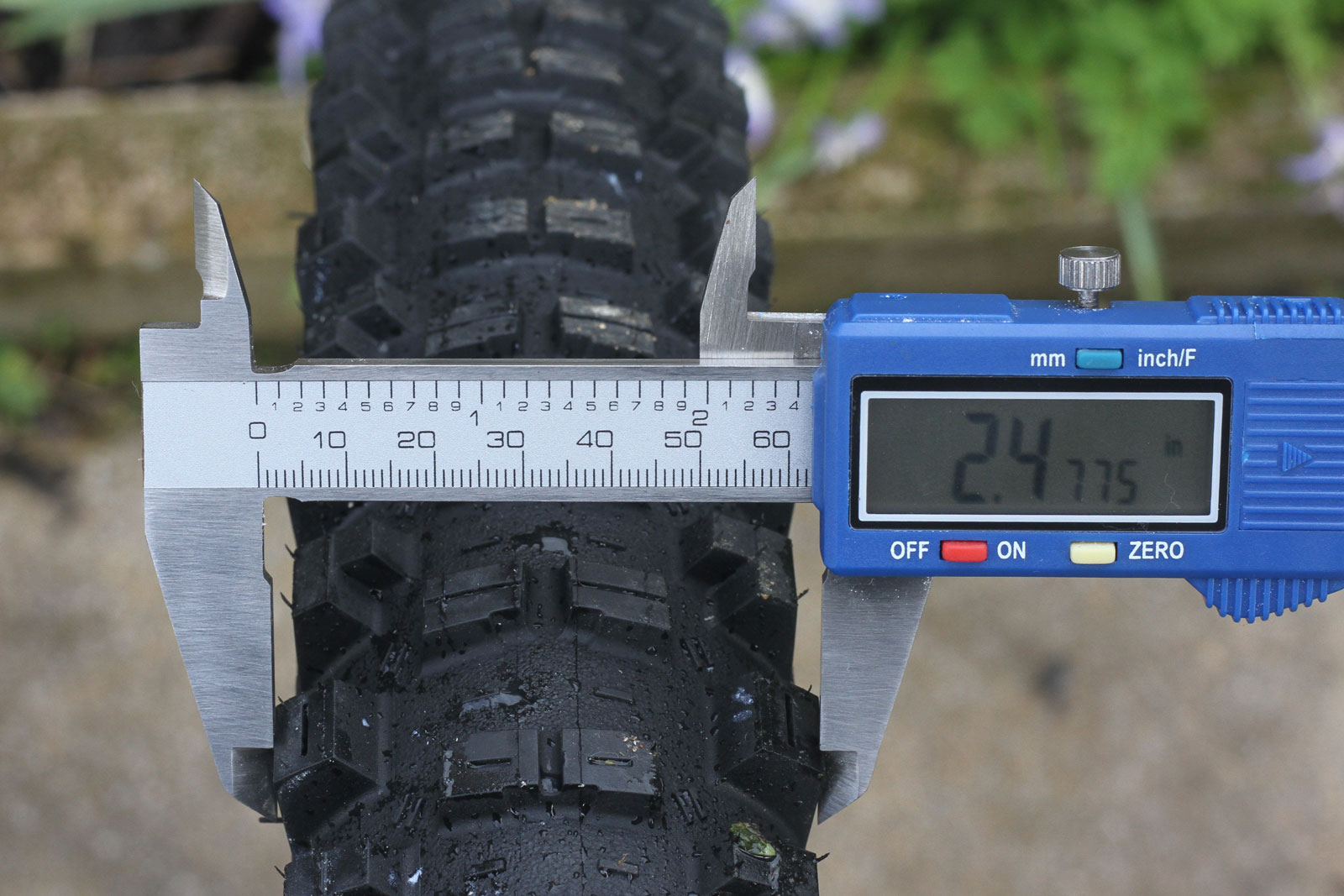
Goodyear Newton Actual Weights
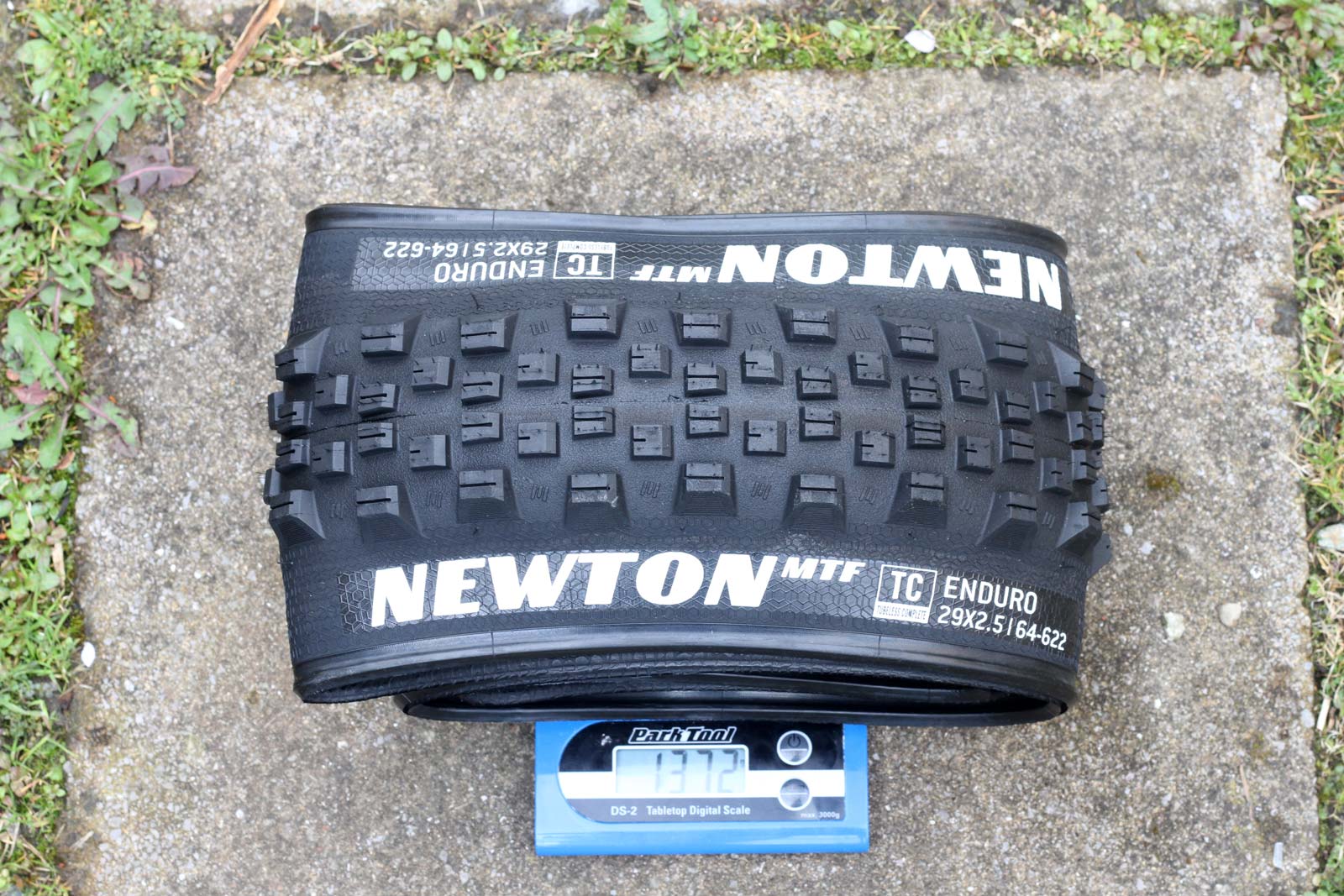
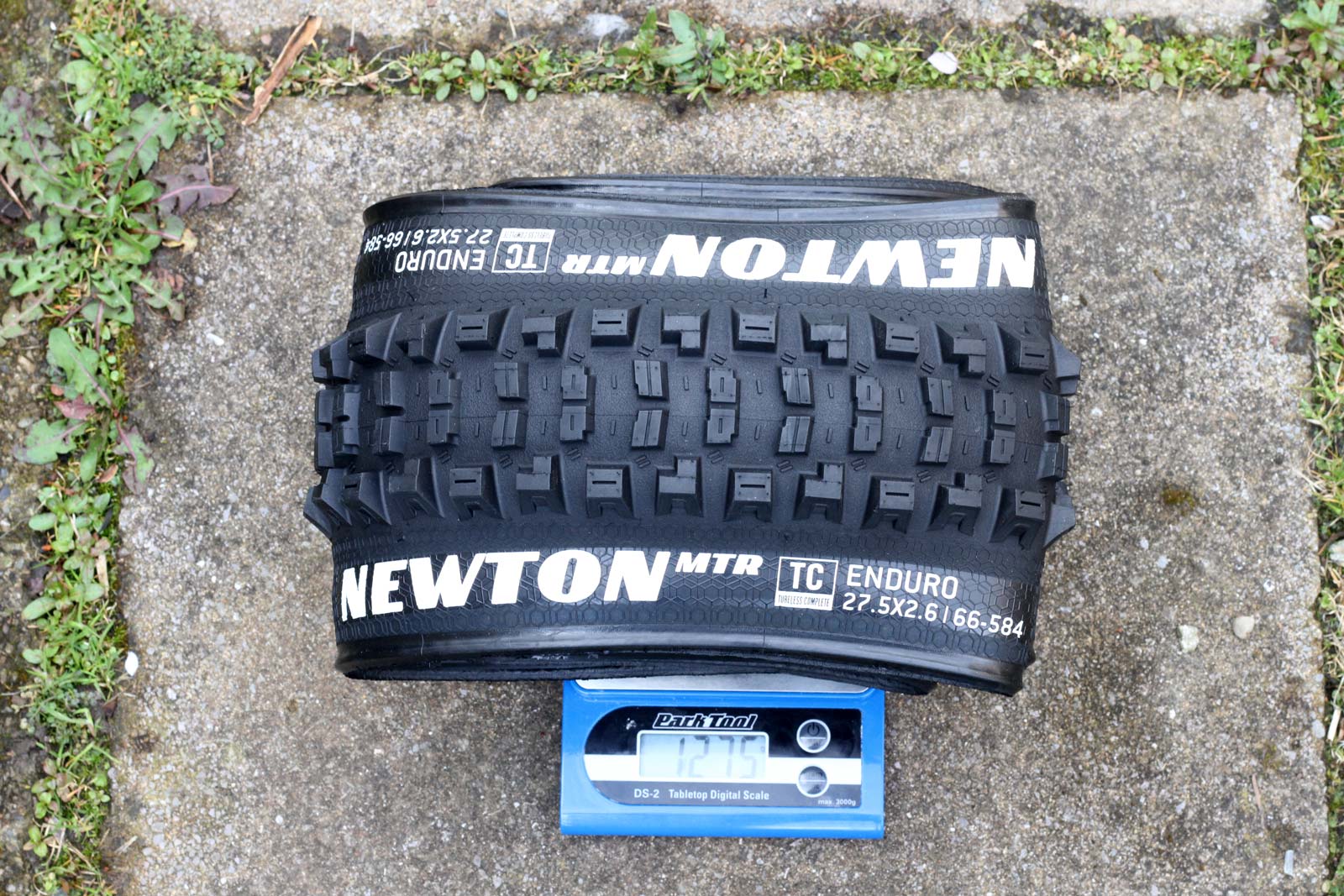
Pricing & Availability
The Goodyear Newton mountain bike tires are fairly reasonably priced in today’s market, especially considering the recent price hikes we’ve seen across the industry. RRP starts at £59.40 for the Trail Casing tires, increasing £66.08 for the Enduro Casing tires, topping out at £71.50 for the Downhill Casing tires.
| Goodyear Tire | Tire Size | GBP (RRP) | EUR (RRP) |
| Newton MTR Trail | 27.5″ x 2.4″ | £59.40 | € 53.90 |
| Newton MTR Enduro | 27.5″ x 2.4″ | £66.08 | € 60.48 |
| Newton MTR Downhill | 27.5″ x 2.4″ | £71.50 | € 64.90 |
| Newton MTR Trail | 27.5″ x 2.6″ | £59.40 | € 53.90 |
| Newton MTR Enduro | 27.5″ x 2.6″ | £66.08 | € 60.48 |
| Newton MTR Downhill | 27.5″ x 2.6″ | £71.50 | € 64.90 |
| Newton MTR Trail | 29″ x 2.4″ | £59.40 | € 53.90 |
| Newton MTR Enduro | 29″ x 2.4″ | £66.08 | € 60.48 |
| Newton MTR Downhill | 29″ x 2.4″ | £71.50 | € 64.90 |
| Newton MTF Trail | 27.5″ x 2.5″ | £59.40 | € 53.90 |
| Newton MTF Enduro | 27.5″ x 2.5″ | £66.08 | € 60.48 |
| Newton MTF Downhill | 27.5″ x 2.5″ | £71.50 | € 64.90 |
| Newton MTF Trail | 29″ x 2.5″ | £59.40 | € 53.90 |
| Newton MTF Enduro | 29″ x 2.5″ | £66.08 | € 60.48 |
| Newton MTF Downhill | 29″ x 2.5″ | £71.50 | € 64.90 |
